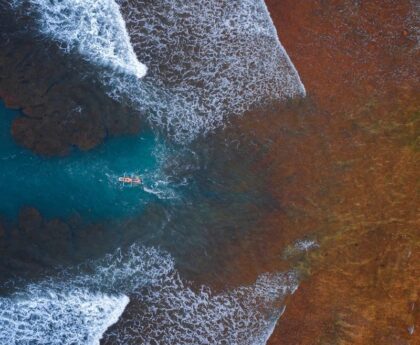The Tragedy of the Titan: Understanding Debris Fields and Implosions
By
The recent news of the missing submersible, Titan, that disappeared en route to the wreckage of the Titanic has left many people searching for answers about the event. The U.S. Coast Guard has confirmed that the submersible imploded while underwater, leading to the presumed deaths of all five individuals on board. In their search for the wreckage, investigators came across a debris field, which raises questions about what exactly a debris field entails, as well as what an implosion is and how it differs from an explosion.
Understanding Debris Fields
A debris field refers to an area where parts of a vessel that have been destroyed or damaged are scattered. In the case of the Titan submersible, the debris field was located on the ocean floor, where pieces of the vessel were discovered. Expert Paul Hanken explains that five major pieces of debris were found, including the nose cone and the front end bell of the pressure hull, indicating a catastrophic event had taken place.
The Coast Guard is continuing its search efforts near the Titanic shipwreck to gather more clues about the submersible and the cause of the implosion. The search is being conducted using remotely operated underwater vehicles (ROVs) that can scan the sea floor. It is a challenging and unforgiving environment, as Rear Adm. John Mauger of the Coast Guard warns.
The Implosion Phenomenon
An implosion occurs when the external pressure on an object is greater than the internal pressure, causing it to collapse inward violently. It is the opposite of an explosion, where pressure builds inside an object and pushes outward. In the case of the Titan submersible, the implosion likely occurred due to the pressure outside the vessel. Rear Adm. Mauger confirms that the debris found is consistent with the catastrophic loss of the pressure chamber.
It is important to note the distinction between an implosion and an explosion. In an explosion, the force radiates outward from the object, while in an implosion, the force collapses the object upon itself, minimizing its volume. Implosions can also cause parts of the object to be ejected outward as other parts collapse.
The Difference between a Submarine and a Submersible
Another point of confusion arises around the terminology used for the missing vessel. The Titan is a submersible, not a submarine. The National Oceanic and Atmospheric Administration explains that a submarine has enough power to travel from port to port independently. In contrast, a submersible has more limited power and range, requiring a mother ship for launching, returning, and support. The Titan’s mother ship is the Polar Prince, a former Canadian Coast Guard icebreaker.
The Significance of the Water Column
During the press conference, experts discussed the location of the debris field in relation to the Titanic. The debris field was found about 1,600 feet from the bow of the shipwreck, in an area without any Titanic debris. Retired captain and Woods Hole Oceanographic Systems Laboratory Director Carl Hartsfield explained that this location is consistent with an implosion in the water column.
The water column refers to all the water in the ocean between the surface and the seafloor. In other words, the implosion could have occurred at any point after submerging but before reaching the ocean floor.
Editorial: Reflections on the Titan Tragedy
The tragic events surrounding the Titan submersible remind us of the inherent dangers and hidden risks that exist in exploring the depths of the ocean. The unforgiving environment, extreme pressure, and unpredictable circumstances make such expeditions perilous undertakings.
The loss of five lives serves as a somber reminder that even with advanced technology and extensive preparations, accidents can happen. The crew members who perished were experienced professionals who dedicated themselves to exploring and documenting the Titanic’s decay and the surrounding ecosystem. Their passion for underwater exploration will be remembered.
This tragedy also raises questions about the safety protocols and technology utilized in submersible exploration. As the investigation unfolds, it is crucial to examine the factors that contributed to the implosion and ensure that lessons are learned to prevent similar incidents in the future.
Advice for Future Underwater Expeditions
Given the inherent risks involved in underwater exploration, it is imperative that adequate safety measures and precautions are taken. Here are some considerations for future expeditions:
1. Robust Safety Measures: The safety of crew members must be the top priority. Submersibles should be equipped with state-of-the-art technology, emergency communication systems, and fail-safe mechanisms to mitigate risks and respond to potential emergencies.
2. Comprehensive Risk Assessment: Thorough risk assessments should be conducted before each expedition, taking into account the specific environmental conditions, vessel capabilities, and crew qualifications. This will help identify and address potential hazards proactively.
3. Training and Professionalism: Crew members should undergo rigorous training and possess the necessary qualifications and experience to handle the challenges of underwater exploration. Regular drills and simulations can enhance preparedness and ensure a swift response in the event of an emergency.
4. Collaboration and Knowledge Sharing: The ocean exploration community should foster a culture of collaboration, sharing lessons learned, and best practices. Establishing industry-wide standards and guidelines can contribute to safer expeditions and continuous improvement.
5. Environmental Stewardship: While exploring the depths of the ocean, it is essential to prioritize environmental preservation and minimize any impact on delicate ecosystems. Responsible exploration practices, such as avoiding damage to underwater sites and respecting marine life, should be followed.
In conclusion, the tragedy of the Titan submersible serves as a stark reminder of the risks involved in underwater exploration. Understanding terms like debris fields and implosions, along with evaluating safety protocols and learning from this incident, will contribute to safer and more informed future expeditions. It is our collective responsibility to ensure the well-being of those who are driven to explore the mysteries of the deep.

<< photo by Woliul Hasan >>
The image is for illustrative purposes only and does not depict the actual situation.




